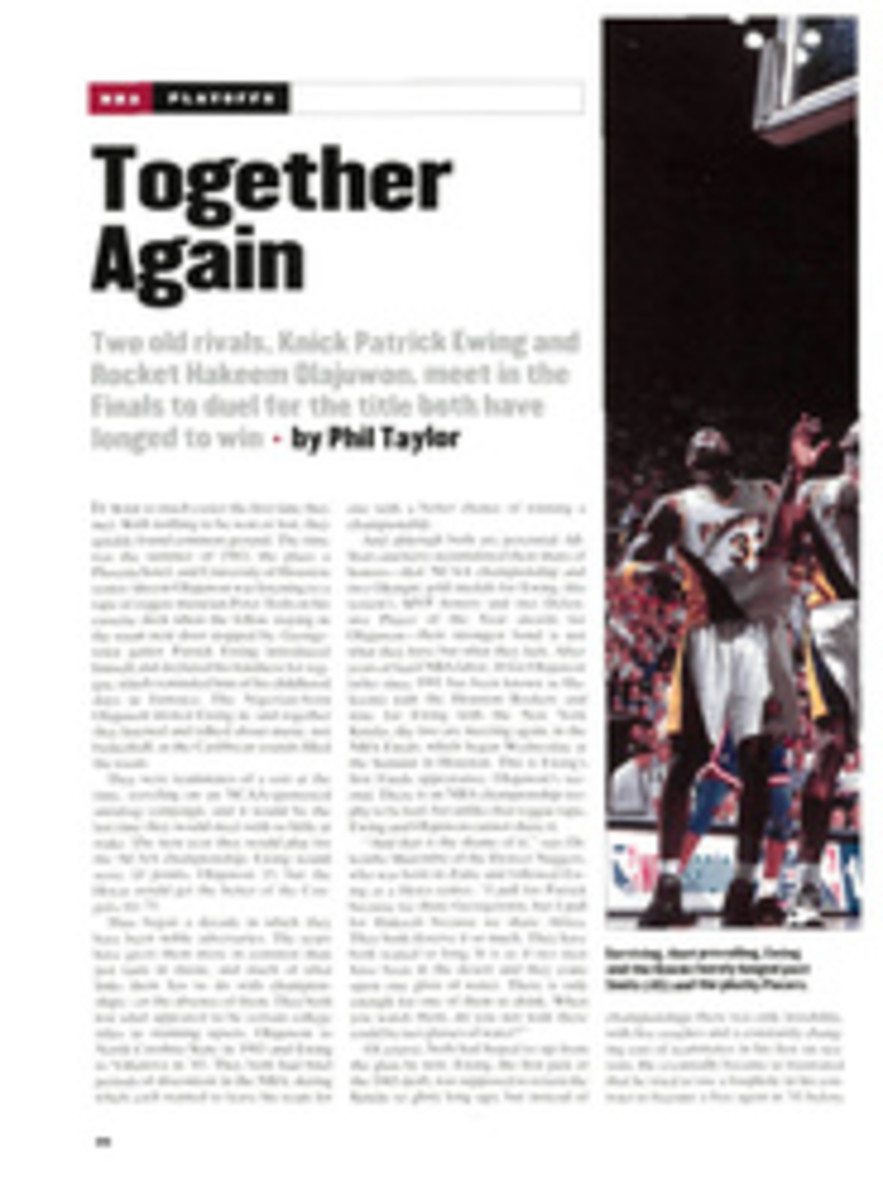
Land of the Midnight Fun
At precisely midnight last June 25, Jason Magee, a meteorologist with the U.S. Navy, stood next to his golf ball at the bottom of a craterlike sand trap and gazed up at the sun. He was playing the par-5 3rd hole at the Akureyri Golf Club, in Akureyri, Iceland, the most northerly 18-hole course in the world. Magee and 91 other eccentric golfers were competing in the first round of Iceland's premier golf tournament, the Arctic Open. Magee was learning the hard way what the links are like 60 miles south of the Arctic Circle.
The mounds of jagged volcanic rock lining the fairways, the mud slicks fronting the greens and the incessant polar winds made a mockery of players' handicaps. But there were never any worries about fading daylight. Thanks to Iceland's boreal location, in the North Atlantic between Greenland and Norway, the sun does not set between mid-June and mid-August. Instead, it bounces around the horizon, dipping and rising in a bizarre cycle of dawn, noon, dusk, dawn, noon, dusk. So during the competition—play was scheduled on two days from 8 p.m. to 6 a.m.—poor visibility was not a concern.
Magee, 23, who was stationed at the NATO base in the southern town of Keflavík, was playing in his fourth Arctic Open. He had finished in the top five in his first three tries and had high hopes of taking home the winner's trophy before his four-year tour of duty ended. But it took no more than a few ill-timed gusts of wind, an unfortunate bounce off a rock into a thicket of gorse and a bull's-eye in a muddy bunker to make Magee realize, by the end of the first day, that he would be returning home empty-handed.
Magee instead settled, as many Icelandic golfers do, for taking in the view. The Akureyri Golf Club sprawls across a grassy plateau surrounded by snow-streaked granite mountains and the green waters of Iceland's northern fjords. Even from the depths of his bunker, Magee could see Arctic terns looping lazily through clouds and golden-maned Icelandic horses racing across fields of dandelions so vast that the Icelanders call them soley—sun islands. Then, of course, he could stare at the real sun, the midnight sun, which gradually dipped behind the Kaldbakur (cold-backed) Mountains, only to reemerge three hours later, just about the time Magee trudged into the clubhouse with a 10-over-par 81, on his way to an eventual 17th-place finish.
"You've got to be crazy to come all this way to play golf," said the 1990 and '92 Arctic Open champion, John Drummond, after his even-par first round left him in second place, two shots back. "But if you can become a good player in Iceland, you can be a good player anywhere in the world." Drummond, who is from York, England, spent seven seasons as a pro at a course in Iceland before joining the Swedish pro tour in 1992. He has seen thousands of balls lost in the Icelandic raff, repaired hundreds of shafts broken upon volcanic rock and putted on greens that could double as hockey rinks. "If it's between April and September, it doesn't matter how horrid the conditions are," Drummond says, "Icelanders will play golf."
Iceland—about the size of Ohio, with a population of 260,000—gained independence from Denmark in 1944 and now boasts one of Europe's highest standards of living. Unemployment, homelessness, pollution and violent crime are virtually unheard-of, and the life expectancy is among the highest anywhere. There are 42 courses in Iceland, most built after 1980. The country has several full-time golf teachers, its own series of instructional golf videos and dozens of local tournaments. During this year's Masters more than 300 Icelanders jammed into the clubhouse at the Akureyri Golf Club and stayed up all night watching the live television coverage. "Ten years ago, if you were a golf player in Iceland, you knew all the other players by first name," says Gunnar Solnes, president of the Akureyri Golf Club. "Now interest in the sport has exploded. Where else can you play 24 hours a day during the summer and never have to wait for a tee time? I think people are crazy not to play here."
Akureyri is a fishing community of 15,000 and the largest city in northern Iceland. From a distance its 6,400-yard golf course could be mistaken for one of the surrounding pastures. Like all of Iceland, the course is long on rocks and short on trees—the climate is too severe to support anything sturdier than a large bush. Also typically Icelandic is the sparse ground cover; one player quipped that a better name for the greens would be the grays.
But the Akureyri course is impressive. It was built in 1935—only the Reykjavík Golf Club, completed a year earlier, is older—and it hosted Iceland's first national tournament, in 1946. Ever since, Akureyri has been considered the country's course of record. The club boasts nearly 600 members. Jack Nicklaus, who goes to Iceland to fish, once hit a few practice drives off the first tee. His photo, along with a pair of autographed golfing gloves, hangs in the clubhouse.
The 36-hole Arctic Open is Iceland's only international tournament. It was established in 1986 (this year's Open, the ninth, will be held on June 23-25) and draws 60 or so of the best players in Iceland, a handful of pros from European circuits and a few dozen golf zealots from the rest of the world—people whose fanaticism is usually far greater than their skill. The '93 Open attracted 36 players from five foreign countries, all of whom went solely for fun. The winner—men and women compete together—receives a large silver-plated trophy; the person who comes closest to making a hole in one gets an Icelandic lambskin rug.
Quality of play at the Arctic Open is, in a word, poor. Last year more than one person banged his first shot off a metal sign advertising locally brewed Viking beer. The sign is about 10 feet in front of the first tee and off to the left side; for a golfer to hit the sign requires a hook of stupendous proportions. The average 36-hole score in the Open was a 47-over-par 189. Louise Wakeman, a 70-year-old grandmother from Connecticut, set what must be a record for being terribly consistent, or consistently terrible. In finishing second to last, she shot two identical scores, both 81-over-par 152s.
The tournament's best rounds by far were served up in the clubhouse bar. The day before play began, the Open welcomed its field with an Icelandic-style cocktail party. Spread out on long wooden tables in the two-story white stucco clubhouse were silver platters filled with regional delicacies. There were long sheets of dried haddock, Iceland's version of beef jerky, along with sheep-liver p‚Äö√†√∂¬¨¢tè, five types of marinated herring, and pumpernickel bread that had been baked inside one of Iceland's many steaming fumaroles. But the highlight of the reception was the traditional eating of hàkarl—pickled shark meat—with a shot of brennivin, Iceland's 80-proof firewater. Hàkarl, served in raisin-sized chunks, smells like ammonia—the stench filled the entire room—and is virtually inedible to anyone who isn't Icelandic.
The first round of the tournament was played in 40° weather with bone-chilling winds. The leader, Arnar Màr Olafsson, shot a two-under 69, an astonishing score considering the conditions. Olafsson, 27, is the first Icelandic golfer to become a fully qualified pro. He represents Iceland in World Cup play and earns his living teaching at the Keilir Golf Club, near Reykjavík. He had finished second and third in the two previous Opens and was desperately trying to win his country's most prestigious title. However, on the second day, which was colder than the first and drizzly as well as windy, his game began to unravel. After 34 holes Olafsson was two shots behind the two-time champion, Drummond, and the Open appeared to be over. But on the long par-5 17th, Olafsson made it to the edge of the green in two, then chipped and putted for a birdie, while Drummond fought a losing battle with the elements and ended up with a bogey. Both parred the short 18th and ended regulation play tied at 146.
The playoff, a replay of the 18th hole, started at 6:15 a.m. Both players were battling exhaustion and hypothermia but somehow made good tee shots. Drummond's landed on the front edge of the green, Olafsson's a bit short of it. On his second shot Olafsson's nine-iron took him four feet from the cup. Drummond then two-putted for par. Olafsson, who needed to sink his putt to continue the playoff, hit a slow, uphill roller that stopped a quarter of an inch from the cup, and Drummond celebrated, his third Arctic Open title in four years.
Olafsson was almost too numb to react. The best he could do was wring his hands and stare at the heavens. Meanwhile, glowing behind a blanket of clouds, the sun was winding its way inexorably around the horizon.
PHOTO
RUNAR THOR
As the locals say, "Where else can you play 24 hours a day and never wait for a tee time?"
PHOTO
RUNAR THOR
The rugged course at Akureyri is long on rocks and short on vegetation.
Michael Finkel, who lives in Bozeman, Mont., is a frequent contributor to Sports Illustrated.

